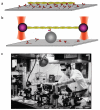One path to understanding energy transduction in biological systems
- PMID: 23042356
- PMCID: PMC4799657
- DOI: 10.1038/nm.2924
One path to understanding energy transduction in biological systems
Figures






References
-
- Huxley HE. The mechanism of muscular contraction. Science. 1969;164:1356–1365. - PubMed
-
- Spudich JL. The multitalented microbial sensory rhodopsins. Trends Microbiol. 2006;14:480–487. - PubMed
-
- Spudich JA, Hastings JW. Inhibition of the bioluminescent oxidation of reduced flavin mononucleotide by 2-decenal. J. Biol. Chem. 1963;238:3106–3108. - PubMed
-
- Spudich JA, Huxley HE, Finch J. Regulation of skeletal muscle contraction. II. Structural studies of the interaction of the tropomyosin-troponin complex with actin. J. Mol. Biol. 1972;72:619–632. - PubMed
Publication types
MeSH terms
Substances
Personal name as subject
- Actions
Grants and funding
LinkOut - more resources
Full Text Sources

